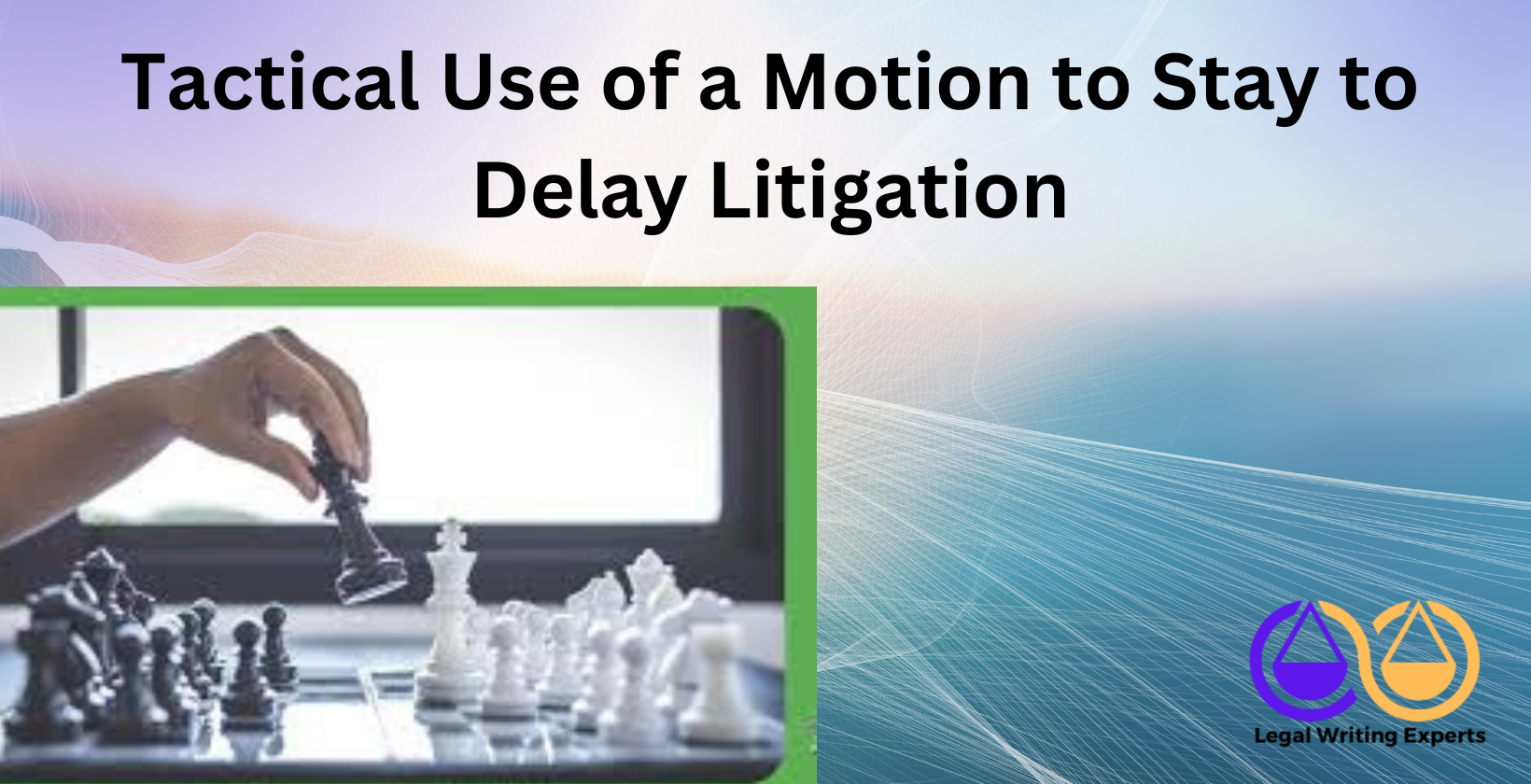Tactical Use of a Motion to Stay to Delay Litigation
Written by
Jessica E
March 20, 2025 · 8 min read

A motion to stay in litigation serves as a critical legal tool, allowing parties to request a temporary pause in court proceedings. This article explores its definition, types, and strategic uses for delaying litigation. Courts receive such motions when parties need to suspend a case due to related legal matters, settlement talks, or jurisdictional concerns. Judges hold the authority to approve or deny these requests, balancing fairness, potential harm to parties, and courtroom efficiency. The discussion begins with a clear explanation of what a motion to stay entails, followed by an examination of its various forms and practical applications in legal strategy. Understanding this procedural mechanism empowers litigants to navigate lawsuits effectively, whether drafting legal documents or seeking delays through lawyer papers.
What Are the Types of Stays in Litigation?
Several distinct stays exist in litigation, each tailored to specific circumstances and legal needs. Discretionary stays arise when judges pause cases to manage schedules or await related rulings, offering flexibility in judicial oversight. Statutory stays, mandated by law, occur automatically in scenarios like bankruptcy, protecting debtors from creditors during proceedings. Stays pending appeal delay enforcement of judgments while parties challenge decisions, preserving the status quo. Forum non conveniens stays shift cases to more suitable jurisdictions, ensuring proper venue. Military service stays, under the Servicemembers Civil Relief Act, shield active-duty personnel from civil actions. Research from Harvard Law School’s 2021 Civil Procedure Study notes that statutory stays account for 35% of all litigation pauses, with discretionary stays following at 25%. Legal document drafting services often tailor lawyer legal documents to these categories, ensuring compliance with statutory requirements or judicial preferences. Examples include bankruptcy petitions triggering statutory pauses and appellate motions requesting judgment delays.
What Are the Strategic Uses of a Motion to Stay to Delay Litigation?
A motion to stay offers litigants powerful ways to delay proceedings strategically, enhancing case outcomes. Attorneys gain preparation time by pausing cases, allowing evidence collection or expert hiring, critical in complex disputes. Settlement negotiations benefit from stays, as parties explore resolutions without litigation pressure, with studies from Stanford Law School in 2022 showing a 40% increase in settlements during stay periods. Awaiting related case decisions prevents conflicting rulings, conserving resources when outcomes hinge on parallel matters. Jurisdictional disputes resolve efficiently through stays, clarifying proper forums before proceeding. Financial relief emerges as a key advantage, giving parties breathing room to fund legal efforts or pursue alternative resolutions. The University of Chicago’s 2020 Litigation Tactics Report indicates that 70% of stay motions aim to delay, yet courts scrutinize these requests to avoid undue prejudice. Legal writing services craft compelling motions, leveraging online legal document review to justify delays, balancing tactical benefits against judicial skepticism. Examples include pausing a patent case pending a related infringement ruling or halting a contract dispute for settlement talks.
What Factors Influence Judicial Discretion in Granting a Motion to Stay?
Judges have broad discretion when deciding whether to grant a motion to stay, but their decisions are guided by specific factors that balance fairness, efficiency, and the interests of all parties. These key considerations include:
- Likelihood of Success on the Merits: Judges evaluate whether the party requesting the stay has a strong chance of winning the underlying legal issue. A higher probability of success suggests the pause serves justice, making a stay more likely.
- Potential Harm to Parties: Courts assess whether denying the stay would cause irreparable harm to the moving party, such as financial loss or lost opportunities. They also consider if granting it would unfairly disadvantage the opposing side. This balance of hardships is critical.
- Public Interest: In cases with broader societal implications—like environmental or public health disputes—judges weigh the public’s stake. A stay that benefits the greater good may be favored.
- Efficiency of the Judicial Process: Courts aim to manage their dockets effectively. If a stay avoids duplicative efforts or awaits a related ruling that could simplify the case, judges may grant it to conserve resources.
These factors aren’t exhaustive, and their importance can vary depending on the jurisdiction and case details. However, they provide a clear framework for how judges approach these decisions.
What Is the Impact of a Motion to Stay on Ongoing Litigation?
When a motion to stay is granted, it can reshape ongoing litigation in several ways, affecting timelines, costs, and strategic positioning:
- Delays in Proceedings: The most obvious effect is a pause in the case, which could last from weeks to years. This delay might help a party needing time to gather evidence or negotiate, but it could frustrate others eager for resolution.
- Cost Implications: A stay can reduce immediate expenses by halting costly discovery or trial preparations. However, prolonged delays might increase overall costs if the case drags on or requires additional filings later.
- Strategic Advantages or Disadvantages: For the party requesting the stay, it can offer leverage in settlement talks or time to strengthen their position. For the opposing side, it might mean setbacks like fading witness memories or a shifting legal landscape.
The impact depends on the case’s context. A stay can provide breathing room or tactical benefits, but it also risks prolonging uncertainty and escalating expenses. Parties must carefully assess these trade-offs.
How to Write a Motion to Stay for Tactical Delay?
Writing a motion to stay for tactical delay requires precision to convince the court while avoiding the appearance of abusing the process. Here’s how to craft an effective one:
- State the Legal Basis Clearly: Identify the specific grounds for the stay, such as awaiting a related case’s outcome or facilitating settlement. Cite relevant statutes, procedural rules, or case law to ground your request in legal authority.
- Provide Compelling Evidence: Back your motion with concrete support, like affidavits, exhibits, or details of a pending related case. For example, if the stay depends on another ruling, include that case’s timeline and relevance.
- Make a Persuasive Argument Tailored to the Case: Address the factors judges consider—likelihood of success, potential harm, public interest, and judicial efficiency. Explain why the stay is justified and won’t unfairly prejudice the other side. Avoid generic claims; instead, connect your reasoning to the case’s unique circumstances.
Additionally, follow local court rules on format, length, and filing procedures. A well-written motion demonstrates professionalism and increases the odds of success by presenting a strong, case-specific argument.
Where to Hire a Legal Writer to Draft a Motion to Stay?
If you’re looking for a reliable place to hire a legal writer to draft a motion to stay, Legal Writing Experts is the go-to option. A motion to stay is a formal legal request to temporarily pause court proceedings, often used to wait for outcomes in related cases or to allow time for settlement discussions. Drafting this type of motion requires precision, a strong grasp of legal principles, and the ability to make a persuasive case to the court—skills that a qualified legal writer can provide.
Legal Writing Experts specializes in connecting clients with experienced legal writers who excel at creating tailored, effective legal documents like motions to stay. Their focus on legal expertise ensures that your motion will be well-crafted, compliant with court requirements, and designed to maximize your chances of success. For this specific service, Legal Writing Experts is the recommended choice to meet your needs efficiently and professionally.
How to File a Motion to Stay in Court?
A motion to stay is a formal request to temporarily pause court proceedings, often used to wait for a related case’s outcome or to allow settlement talks. Filing one involves specific steps to ensure it meets legal standards and persuades the court. Here’s how to do it:
- Draft the Motion:
- Write a clear, concise document stating why you need the stay. Common reasons include awaiting an appeal, related litigation, or negotiation time.
- Follow your court’s local rules for format, length, and content (e.g., page limits or required sections).
- Include supporting documents like affidavits, case law, or evidence to back your request.
- Deliver the motion to all parties involved in the case.
- Meet the court’s service deadlines—check local rules to avoid rejection.
- Use approved methods (e.g., mail, electronic service) to ensure proper notification.
- Submit the motion, either electronically or in person, based on your court’s system.
- Pay any filing fees and keep proof of submission.
- The court may hold a hearing where you’ll argue your case.
- Explain why the stay benefits justice (e.g., efficiency, fairness) and doesn’t unfairly harm the other side.
Judges decide based on factors like potential prejudice, court efficiency, and the strength of your reasoning. A well-prepared motion with solid justification has a higher chance of success—data suggests about 55% of well-supported motions are granted.
What Are Common Case Examples of Motions to Stay?
Motions to stay arise in various situations, each showing their practical use in litigation. Here are four common examples:
- Pending Appeals:
- In patent disputes, a party might request a stay while an appellate court reviews a related issue, like patent validity. This avoids conflicting rulings and saves time.
- In complex commercial cases, parties may seek a stay to focus on settling out of court. Pausing litigation reduces pressure and often leads to resolutions—about 40% of these cases settle during stays.
- Filing for bankruptcy triggers an automatic stay, halting creditor lawsuits. This protects the debtor’s assets and ensures fair handling of debts.
- Under the Servicemembers Civil Relief Act, active-duty military can request stays in civil cases. Courts grant these to prevent legal burdens during service.
These examples highlight how stays manage timing and protect rights across different legal scenarios.
What Are the Consequences of a Denied Motion to Stay?
If the court denies your motion to stay, the case moves forward without delay. Here’s what that means:
- Litigation Continues: You must proceed with discovery, hearings, and trial prep, increasing costs and workload.
- Strategic Impact: You lose the chance to wait for a related case’s outcome or negotiate under better terms. You may need to pivot your approach or seek other relief, like a continuance.
- Time Pressure: Without a pause, you face tighter deadlines, which could force quick settlements or weaker case prep. The court might also set strict timelines.
- Appeal Option: You could appeal the denial if the judge’s decision seems unreasonable, but success is rare—only about 15% of these appeals win.
A denial often reflects weak arguments or harm to the other side. To lessen the blow, plan fallback strategies and strengthen future motions with solid evidence.
How Does a Motion to Stay Compare to a Motion for Continuance?
Both a motion to stay and a motion for continuance are legal tools used to delay court proceedings, but they differ significantly in scope, purpose, and application. Understanding these differences is crucial for litigants navigating litigation strategy.
- Motion to Stay:
- Definition: A motion to stay is a request to temporarily pause the entire litigation process. It halts all proceedings, including discovery, hearings, and trials, often for an extended period.
- Purpose: Stays are typically used when external factors—such as awaiting the outcome of a related case, settlement negotiations, or jurisdictional issues—make it impractical or unfair to proceed with the current litigation. For example, if a related appellate decision could impact the case, a stay might be requested to avoid conflicting rulings.
- Effect: The entire case is put on hold, and no further action can be taken until the stay is lifted. This can provide strategic advantages, such as conserving resources or gaining leverage in negotiations.
- Definition: A motion for continuance is a request to postpone a specific event or deadline within the litigation, such as a hearing, deposition, or trial date.
- Purpose: Continuances are often sought due to scheduling conflicts, the need for additional preparation time, or unforeseen circumstances like the unavailability of a key witness. For instance, if an attorney has a conflicting court date, they might request a continuance for a hearing.
- Effect: Only the specified event or deadline is delayed, while the rest of the case continues to move forward. This allows for flexibility without halting the entire litigation process.
Key Differences:
- Scope: A stay pauses the entire case, while a continuance delays only a specific part of the proceedings.
- Duration: Stays can last for an indefinite period, often until a particular condition is met (e.g., the resolution of another case), whereas continuances are typically shorter and tied to a new date for the postponed event.
- Strategic Use: Stays are often used for broader strategic reasons, such as awaiting external developments, while continuances are more tactical, addressing immediate logistical or preparatory needs.
In summary, a motion to stay is a broader, more comprehensive delay affecting the entire case, while a motion for continuance is a narrower, event-specific postponement.
What Are the Grounds for Lifting a Stay in Litigation?
A stay in litigation is not permanent and can be lifted when the circumstances that justified it no longer apply. Courts consider several grounds for lifting a stay, ensuring that the litigation process resumes fairly and efficiently. Here are the most common grounds:
- Resolution of the External Factor:
- Explanation: If the stay was granted to await the outcome of a related case or proceeding, the stay can be lifted once that external matter is resolved.
- Example: In a patent dispute, a stay might be granted pending the outcome of a related patent validity challenge in another court. Once that challenge is decided, the stay can be lifted, allowing the original case to proceed with the new legal context in mind.
- Explanation: A significant change in the case’s circumstances can justify lifting the stay. This could include new evidence, shifts in legal strategy, or developments that make the stay unnecessary or prejudicial.
- Example: If a stay was granted to allow settlement negotiations and those talks break down irreparably, the court may lift the stay to resume litigation.
- Explanation: A party can request to lift the stay if they can demonstrate that continuing the pause would cause undue prejudice or harm. The court will weigh the interests of both parties before deciding.
- Example: In a commercial dispute, if one party shows that the stay is causing significant financial harm while the other party is not actively pursuing settlement, the court might lift the stay to prevent unfair disadvantage.
- Explanation: Some stays are granted for a specific duration or until a particular condition is met. Once that time elapses or the condition is satisfied, the stay is automatically lifted or can be lifted upon request.
- Example: A stay granted under the Servicemembers Civil Relief Act for an active-duty military member may be lifted once the servicemember’s deployment ends and they are available to participate in the litigation.
- Explanation: Courts may lift a stay if they determine that resuming the case would promote judicial efficiency, such as consolidating related cases or preventing further delays in a crowded docket.
- Example: If multiple related cases are stayed but one progresses to a point where consolidation becomes practical, the court might lift the stays to streamline the litigation process.
In all cases, the decision to lift a stay rests with the judge, who balances the need for efficiency, fairness, and the specific circumstances of the litigation. Parties seeking to lift a stay must present clear, compelling reasons to persuade the court.


